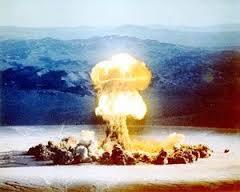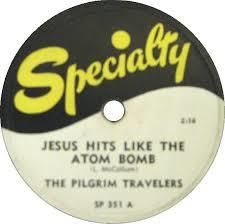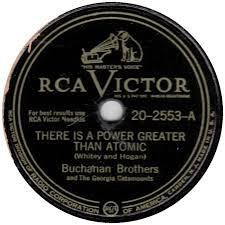If your main thought about the atomic bomb is that you’re just glad no one ever detonated one of those suckers in America, you should maybe think again.
A-Bombs Over Nevada, a special that airs Monday at 9 p.m. ET on the Smithsonian Channel, recounts how the U.S. government set off more than a thousand nuclear explosions on and under American soil.

Atomic bombs routinely lit up the Nevada sky and mountains.
Fearful that the Soviet Union was developing a nuclear arsenal capable of annihilating America, the U.S. government between the early 1950s and early 1960s felt it essential to develop and test ever-more powerful atomic weapons of its own.
This wasn’t a surreptitious program. Probably realizing that something as blinding and powerful as an atomic blast would be hard to keep secret, the government scheduled and announced its tests, which were always conducted at dawn.
In Las Vegas, 65 miles to the north, the blasts soon drew tourists to the fledgling resort city. Thousands of visitors would party and drink all night, then finish it off by putting on a pair of goggles and watching a nuclear flash.
With what we know today about the impact and duration of radioactive fallout, it’s hard to imagine that we would set off nuclear blasts anywhere near civilization. Or anywhere, period, since radioactivity can rise into the clouds and travel the world.
At the time, though, A-Bombs notes, scientists had not yet gauged any of that. Many observers were stationed about five miles from the blast, and thousands of soldiers were placed in trenches only two miles from the detonation.
Enough soldiers later came down with radioactivity-related illnesses that in the 1990s Congress approved compensatory payments, so far totaling more than $800 million.

The Bomb was a popular image in 1950s culture.
Most of the soldiers did fare better than other test subjects like sheep, donkeys and pigs, who were penned up even closer to the blast so scientists could measure the impact.
Often, A-Bombs points out, the impact was elusive, because the animals were vaporized. Those who survived could have become poster subjects for PETA.
A-Bombs Over Nevada spends less time on technical aspects of the atomic bomb than on the historical context of the testing years, that is, why we were so driven to pursue this deadly path.
Less than a year after U.S. nuclear weapons ended the war in Japan, we were already conducting underwater tests around the Bikini atoll in the Pacific, determined to maintain world superiority in the nuclear age.
In 1949, we thought the Soviets were five years from a bomb of their own. We were wrong by about five years, and the first Soviet tests coincided with Mao Zedong’s communist revolution in China.

The optimistic view, more or less.
A chastened and nervous U.S. threw everything it had into the nuclear game, and live in-country tests were considered imperative to assess progress. Several sites were considered, including Alaska and the Outer Banks of North Carolina, before Nevada was deemed ideal because of its low population and extensive open space.
We blasted away until other scientists started finding radioactivity in troubling places like milk, including mother’s milk.
At that point, the pendulum of public approval began to swing rather rapidly away from testing, an arc reflected neatly here in two clips of the late CBS newsman Walter Cronkite.
In 1953, Cronkite is in Yucca Flats, broadcasting live from the scene of an early test. He sounds almost as excited as he would sound 16 years later at the moon landing.
Then in 1958, the same Cronkite goes on the air to rail against testing, warning that it spreads lethal “garbage” that could ruin American health.
Testing eventually stopped, ushering in the uneasy peace that has held in the years since. The specter of “mutually assured destruction” so far has stayed all hands with access to nuclear buttons.
But for a good decade before that, America nuked itself.
